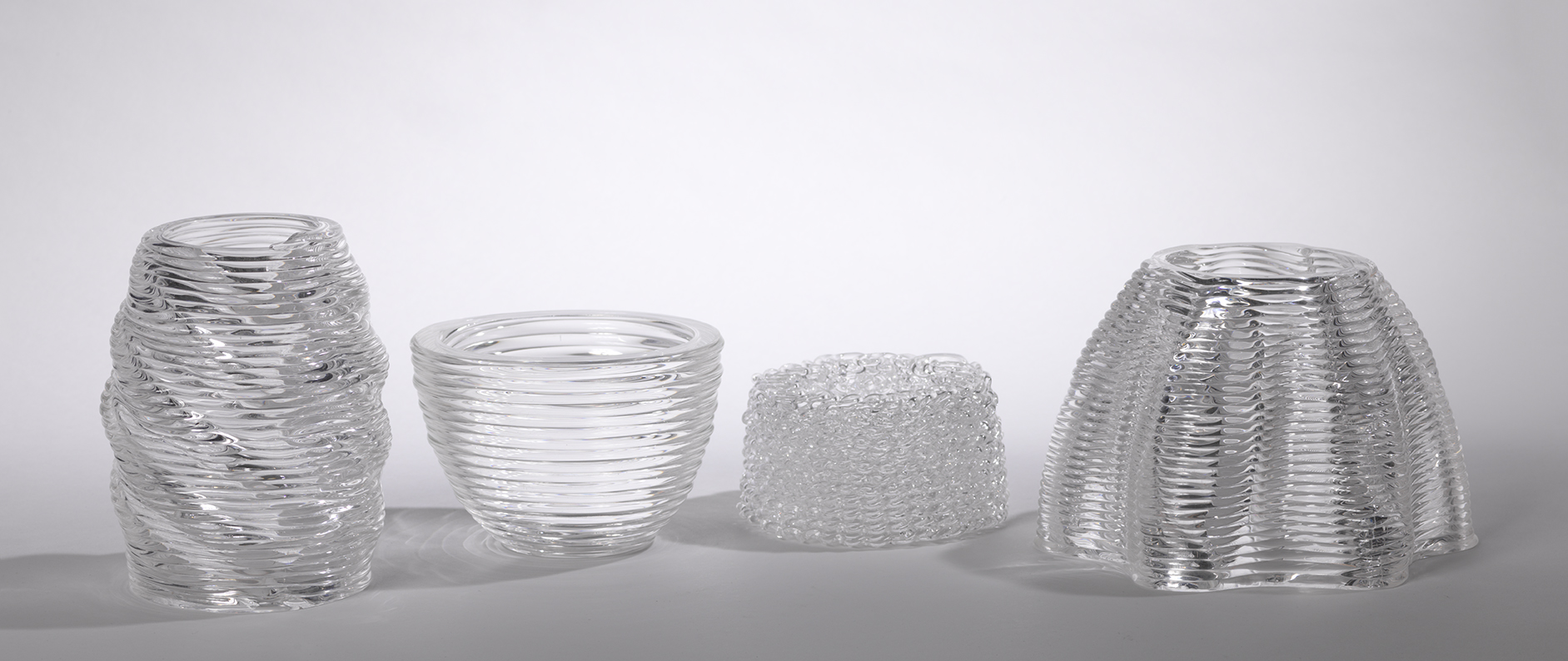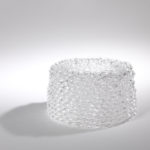The United Nations has designated 2022 the International Year of Glass. Cooper Hewitt is celebrating the occasion with a yearlong series of posts focused on the medium of glass and museum conversation. Catch up on the year.

Vessel Prototypes WV.02, DR.01, DP.01, HY.02 from GLASS series; Designed and fabricated by Neri Oxman (American, born Israel, 1976) and MIT Media Lab Mediated Matter Group (Cambridge, Massachusetts, USA); 3D-printed glass; HY.02 (largest): H × W × D: 21.6 × 21.6 × 13.3 cm (8 1/2 × 8 1/2 × 5 1/4 in.); Museum purchase from General Acquisitions Endowment Fund and through gift of MIT Media Lab, 2016-51-1a/4a
Cooper Hewitt’s collection holds many examples of 3D-printed materials in plastics, ceramics, and metal, but only one example of 3D-printed glass. A group of four 3D-printed glass vessel prototypes in Cooper Hewitt’s collection are experiments for architectural applications in which stacked elements can be lit from within to create glowing columns of glass. According to designer Neri Oxman, “The project synthesizes modern technologies with age-old tools and methods to produce novel structures with numerous potential applications.”
Oxman, lead designer formerly of MIT Media Lab’s Mediated Matter research group and now of the eponymous New York–based firm Oxman Architects, is an innovator across scales and materials of design, with work in natural substances like silk and chitosan, alongside 3D-printed resins, metals, and glass. In 2015, Oxman’s team invented a new way of printing glass using a heated extruder that allowed molten glass to be layered into these dynamic forms.
When working hot glass, motion and temperature control are of premium importance. The patented technology uses robotic control to keep the nozzle and print bed in relation to one another, allowing the filament of glass to avoid experiencing stresses. The 3D printer also needed to heat the glass enough to melt it (within the range of 1040–1165 degrees Celsius) but maintain enough temperature control over the other layers not to introduce stress into the glass. After forming, hot glass must be annealed (cooled slowly at a controlled pace) to reduce stresses in the glass structure (unannealed glass is extremely dangerous and can shatter as thermal stresses rapidly form and propagate). The process developed by Oxman’s team is similar to Fused Deposition Modeling (FDM) printers commonly used to print plastic resins (as opposed to other 3D-printing techniques, such as binder jetting or selective laser sintering that are appropriate for high melting temperature materials but that do not produce optically transparent glass as readily). The process is illustrated in the below video.

Prototypes from the GLASS series, including WV.02, on display at Cooper Hewitt, lit from above to demonstrate how the prototypes interact with light and might have applications with digital media.

DR.01 on display at Cooper Hewitt.

The GLASS series on display in the exhibition Beauty—Cooper Hewitt Design Triennial (2016).
The biomorphic lobed forms of these prototypes echo other works by Oxman and reinforce her integration of bio-inspired design with cutting edge fabrication techniques. The biomorphic forms also relate to other works in glass in the museum’s collection, like Toots Zynsky’s sculptural vessel (1985) made of fused glass threads, along with the more directly imitative famous collections of glass botanical and zoological models by Leopold and Rudolph Blaschka made in the late 19th century and now found in natural history collections.

Sculptural Vessel (Amsterdam, Netherlands), 1985; Designed and made by Toots Zynsky (American, born 1951); Fused and thermo-formed glass threads (filet-de-verre); H × W × D: 13 × 22.5 × 23.2 cm (5 1/8 × 8 7/8 × 9 1/8 in.); Museum purchase through gift of Anonymous Donor, Carol B. Brener and Stephen W. Brener, Mr. and Mrs. Max B. Furman, Bequest of Mrs. John Innes Kane, James M. Osborn, and Thonet Industries, Inc., 1986-20-2
Oxman’s 3D-printed glass objects are beautiful to behold—and make a fitting end to our yearlong series of 2022’s Year of Glass—as demonstrations of what’s to come in glass manufacturing: designers continuing to push the boundaries of what this magical substance can do, linking art and science with their research.
Jessica Walthew is a conservator at Cooper Hewitt working with the product design and decorative arts and digital collections.
Further Reading
Antonelli, Paola, with Anna Burckhardt. Neri Oxman: Material Ecology. New York: The Museum of Modern Art, 2020. https://www.moma.org/d/pdfs/W1siZiIsIjIwMjAvMDMvMTgvN3h0aTB0ZDIwZV9Nb01BX094bWFuX1BSRVZJRVcucGRmIl1d/MoMA%20Oxman%20PREVIEW.pdf?sha=b9de8a989ee0332c.
Inamura, Chikara. “Towards a new transparency: high fidelity additive manufacturing of transparent glass structures across scales.” Thesis: S.M., Massachusetts Institute of Technology, School of Architecture and Planning, Program in Media Arts and Sciences, 2017. https://dspace.mit.edu/handle/1721.1/112536.
Inamura, Chikara, et al. Methods and apparatus for additive manufacturing with molten glass. US Patent 10,464,305 B2, filed January 25, 2018, and issued November 5, 2019. https://patents.google.com/patent/US10464305B2/en;.
Klein, John, et al. “Additive Manufacturing of Optically Transparent Glass.” 3D Printing and Additive Manufacturing 2, no. 3 (2015): 201. https://oxman.com/files/85c33ef4-ca38-4a13-919a-4ca1df71bf25/Additive-Manufacturing-of-Optically-Transparent-Glass-(2015).pdf.
Lipps, Andrea, and Ellen Lupton, eds. Beauty—Cooper Hewitt Design Triennial. New York: Cooper Hewitt, Smithsonian Design Museum, 2016. https://www.cooperhewitt.org/publications/beauty-cooper-hewitt-design-triennial/.
Oxman. “Project: Glass II.” Accessed November 2022. https://oxman.com/projects/glass-ii.



